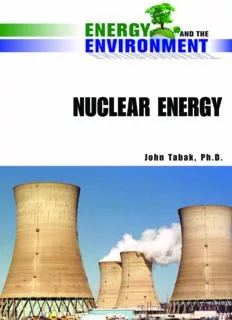
Nuclear Energy PDF
Preview Nuclear Energy
EnErgy And THE EnvironmEnT Nuclear Energy EnErgy And THE EnvironmEnT Nuclear Energy JOHN TABAK, Ph.D. For Steven Howard Myers. He was a good friend and a very funny man. NUCLEAR ENERGY Copyright © 2009 by John Tabak, Ph.D. All rights reserved. No part of this book may be reproduced or utilized in any form or by any means, electronic or mechanical, including photocopying, recording, or by any information storage or retrieval systems, without permission in writing from the publisher. For information contact: Facts On File, Inc. An imprint of Infobase Publishing 132 West 31st Street New York NY 10001 Library of Congress Cataloging-in-Publication Data Tabak, John. Nuclear energy / John Tabak. p. cm.— (Energy and the environment) Includes bibliographical references and index. ISBN-13: 978-0-8160-7085-5 ISBN-10: 0-8160-7085-7 1. Nuclear energy. I. Title. QC792.T33 2009 621.48—dc22 2008026036 Facts On File books are available at special discounts when purchased in bulk quanti- ties for businesses, associations, institutions, or sales promotions. Please call our Special Sales Department in New York at (212) 967-8800 or (800) 322-8755. You can find Facts On File on the World Wide Web at http://www.factsonfile.com Text design by Eric Lindstrom Illustrations by Accurate Art Photo research by Elizabeth H. Oakes Printed in the United States of America Bang Hermitage 10 9 8 7 6 5 4 3 2 1 This book is printed on acid-free paper. Contents Preface ix Acknowledgments xiii Introduction xiv 1 A Prehistory of Nuclear Power 1 The First Heat Engines 2 Carnot and the Efficiency of Heat Engines 11 Radioactive Materials as Sources of Thermal Energy 14 Global Warming and Nuclear Power 18 2 The Physics of Nuclear Fission 23 Atomic Particles 23 Conservation Laws and Radioactive Processes 27 Atomic Fission 34 Fermi’s Reactor 37 3 Reactor Fuel 43 Manufacturing Reactor Fuel 43 Inside the Reactor 50 Nuclear Weapon Proliferation 54 The International Atomic Energy Agency 58 4 Nuclear Reactor Designs 63 Boiling Water Reactors 64 Pressurized Water Reactors 69 The Accident at Chernobyl 72 CANDU Reactors 75 Future Reactor Designs 80 5 Reactor Safety 88 Radiation Effects 90 Independent Redundant Subsystems 95 Where Are the Fatalities? 96 Event Trees 101 6 Spent Fuel 106 The Composition and Characteristics of Spent Fuel 107 Managing Spent Fuel 109 Building for Eternity 115 Is Yucca Mountain Safe Enough? 122 Nonscientific Objections to the Yucca Mountain Site 125 7 The Business of Electricity Production 128 Utilities as Natural Monopolies 128 ISO New England 133 The Nature of Supply and Demand 135 Nuclear Power in the United States Today 142 8 Nuclear Energy and National Policy 146 Some Arguments for Nuclear Power 147 Some Arguments against Nuclear Power 150 Nuclear Power Policy in Germany 152 Nuclear Power Policy in the United States 156 Nuclear Power Policy in France 162 Conclusion 166 Afterword: An Interview with Harold Denton: On the U.S. Nuclear Power Industry 168 Periodic Table of the Elements 177 Chronology 179 List of Acronyms 183 Glossary 184 Further Resources 188 Index 192 Preface N ations around the world already require staggering amounts of energy for use in the transportation, manufacturing, heat- ing and cooling, and electricity sectors, and energy requirements continue to increase as more people adopt more energy-intensive lifestyles. Meeting this ever-growing demand in a way that mini- mizes environmental disruption is one of the central problems of the 21st century. Proposed solutions are complex and fraught with unintended consequences. The six-volume Energy and the Environment set is intended to provide an accessible and comprehensive examination of the history, technology, economics, science, and environmental and social im- plications, including issues of environmental justice, associated with the acquisition of energy and the production of power. Each volume describes one or more sources of energy and the technology needed to convert it to useful working energy. Considerable emphasis is ix
Description: